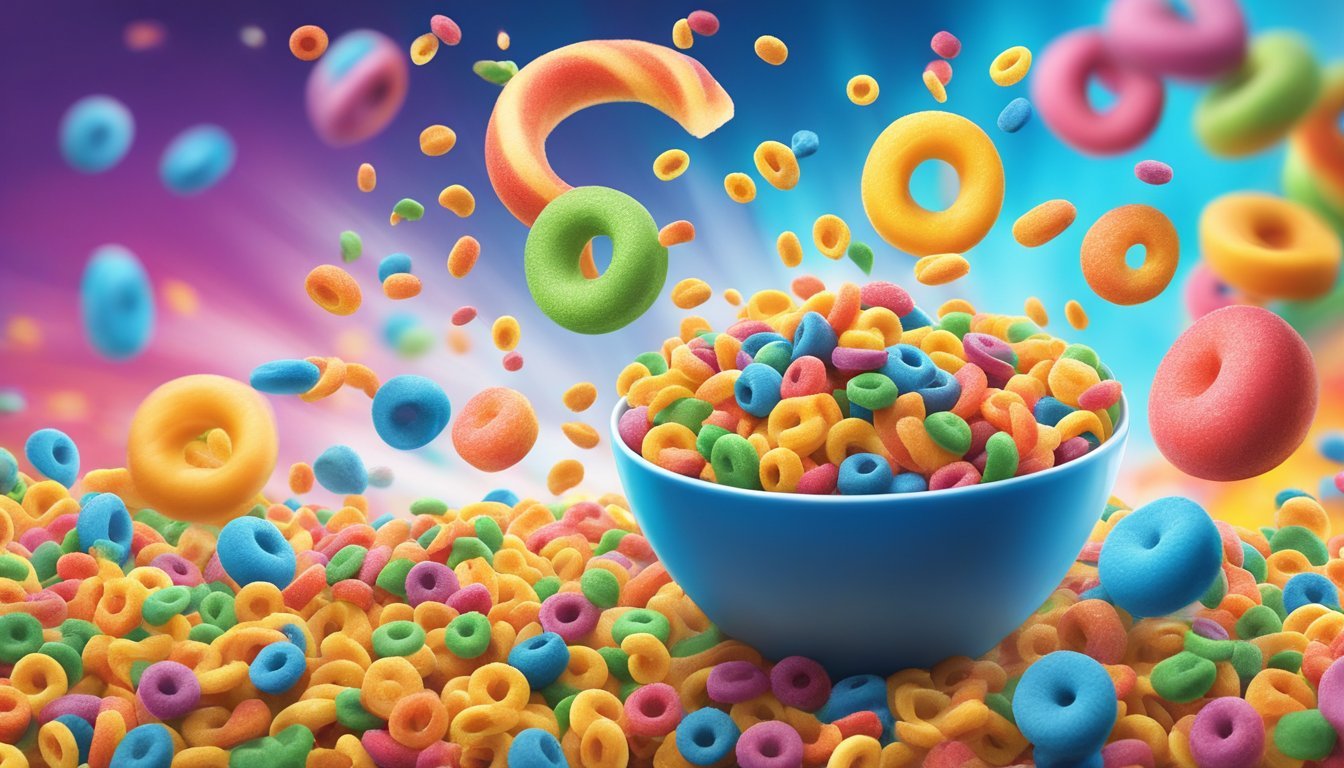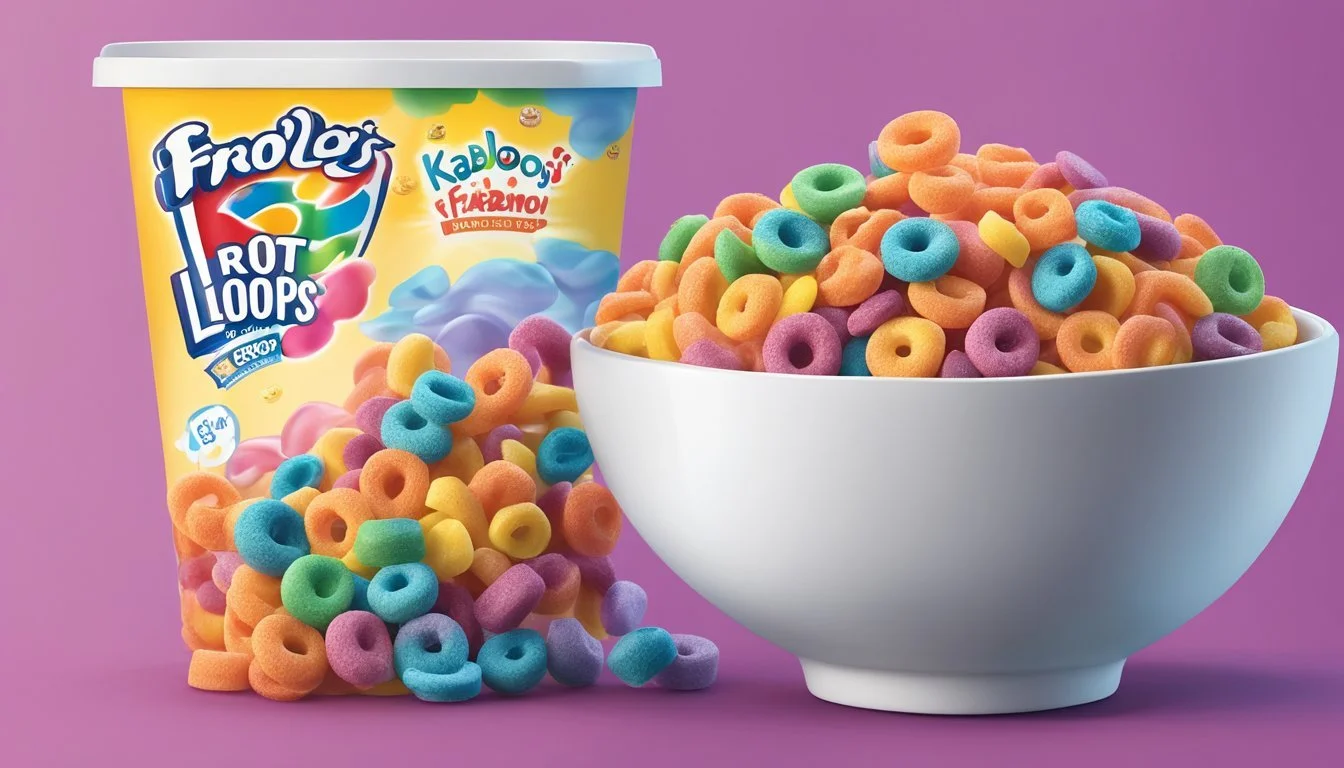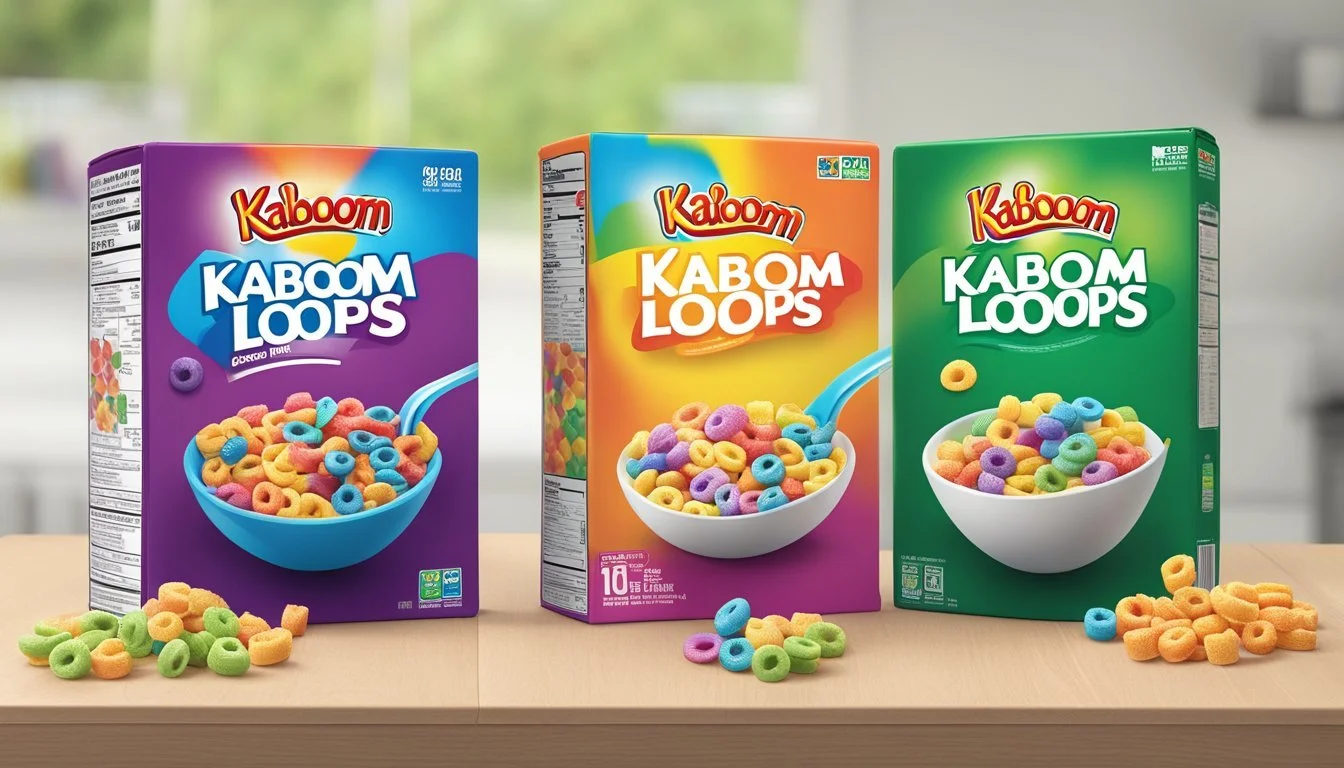Kaboom vs Kellogg's Froot Loops
A Cereal Showdown
This Article is Part of Our Breakfast Cereal Guide with Details on Kaboom Nutrition and Kellogg's Froot Loops Nutrition
Choosing between Kaboom and Kellogg's Froot Loops for breakfast can be tricky for cereal enthusiasts. While both brands offer a sweet and colorful start to the day, they differ significantly in nutritional content and target audience. Kaboom is known for its higher vitamin content, making it a fortified option aimed at providing more essential nutrients.
In contrast, Kellogg's Froot Loops, a popular brand under the Kellogg's umbrella, is rich in fiber and Vitamin C, adding a touch of health benefits to its fruity flavor. Kellogg's Froot Loops has also become a household name due to its wide availability and vibrant marketing. While it doesn't match Kaboom's fortification, its balance of taste and nutritional benefits keeps it competitive.
For those prioritizing specific nutritional needs, the choice becomes clearer. Kellogg's Froot Loops may appeal to those seeking a fiber-rich, fruit-flavored cereal, while Kaboom stands out for its enhanced vitamin content, making breakfast both fun and nutritious.
Historical Background
Kaboom and Kellogg's Froot Loops have distinct origins and developmental paths that highlight their impacts on the breakfast cereal market.
Origin of Kaboom
Kaboom was introduced by General Mills in 1969. It was known for its clown mascot and colorful cereal shapes. Designed primarily for children, Kaboom featured shapes like stars and smiling faces, accompanied by a mix of vitamins and minerals, boasting a nutritional edge compared to other sugary cereals.
Its packaging prominently displayed the clown mascot, making it visually attractive to young consumers. Despite its initial popularity, Kaboom’s prominence declined over the years, eventually leading to its discontinuation. No longer on store shelves, Kaboom remains a nostalgic memory for those who grew up in its era.
Evolution of Kellogg's Froot Loops
Kellogg's Froot Loops debuted in 1963, aiming to offer a bright, fruity alternative to traditional cereals. Created by nutritionist Edward Bagley, the cereal quickly gained fame for its vibrant, ring-shaped pieces and fruity taste. Over the decades, Toucan Sam, the colorful toucan mascot, became an iconic symbol of the brand.
Originally part of the Kellogg Company, Froot Loops transitioned to a new structure when Kellogg’s split its North American cereal division into WK Kellogg Co in 2023. This change marked a new chapter while the product’s core elements—bright colors, fruity flavors, and engaging marketing—remained intact.
Nutritional Profile
Kaboom and Kellogg's Froot Loops both provide various essential nutrients, but they differ in their vitamin and mineral content, macronutrient composition, and levels of sugars and fats.
Comparison of Essential Vitamins and Minerals
Kellogg's Froot Loops are notable for being rich in several vitamins. They are higher in Vitamin A, Vitamin B2, Vitamin B3, and Vitamin B6 compared to Kaboom. For instance, Froot Loops provide a substantial percentage of the daily recommended intake of Vitamin B6.
In contrast, Kaboom offers greater quantities of Vitamin B1, Vitamin B12, Vitamin C, and Vitamin D. Kaboom is particularly rich in Vitamin B1, providing more than 400% of the daily value. Both cereals supply essential minerals like zinc and iron, but Froot Loops have higher quantities of iron and zinc, while Kaboom contains additional beneficial amounts of calcium and phosphorus.
Macronutrients: Fiber, Proteins, and Carbs
When comparing the macronutrient profiles, Kellogg's Froot Loops and Kaboom differ significantly. Froot Loops contain 7 times more fiber than Kaboom, making them better for digestive health. Each serving of Froot Loops offers about 3 grams of fiber.
Kaboom, on the other hand, has slightly more protein and carbohydrates per serving, with approximately 2 grams of protein and a higher carbohydrate count. Both cereals have relatively low amounts of protein overall. Carbohydrate content in both includes sugars and other simple carbs, important for quick energy but requiring moderation.
Analysis of Sugars and Fats
Both cereals contain notable amounts of sugar, affecting their desirability for those limiting sugar intake. Kellogg's Froot Loops have about 12 grams (3 teaspoons) of sugar per serving, making it less suitable for a low-sugar diet.
Kaboom also has high sugar content but lacks specific comparative numbers compared to Froot Loops. As for fats, neither cereal is a significant source, though Froot Loops do list a small amount of fats including saturated fat and no trans fats.
Sodium levels are another consideration, with both cereals containing moderate amounts – important for those monitoring their salt intake. The quantity of sodium often enhances flavor but can impact heart health if consumed in excess.
Ingredient Breakdown
The ingredients in Kaboom and Kellogg's Froot Loops provide insights into their nutritional profiles and potential health impacts. The discussion will focus on the cereal base ingredients and the various additives and preservatives found in both cereals.
Cereal Base Ingredients
Kellogg's Froot Loops uses a corn flour blend, which includes whole grain yellow corn flour and degerminated yellow corn flour. The presence of whole grains boosts the fiber content, contributing to a relatively healthier profile for a sugary cereal.
Kaboom typically incorporates wheat flour and oat flour, offering a different grain base compared to Froot Loops. These flours provide additional fiber and nutrients, thanks to the inclusion of whole grains.
Both cereals include ingredients like whole grain oat flour and salt. However, the primary difference lies in the type of grains used, with Froot Loops favoring corn-based components while Kaboom leans towards wheat and oat derivatives.
Additives and Preservatives
Kellogg's Froot Loops contains a range of color additives such as Red 40, Yellow 5, Yellow 6, and Blue 1. These artificial colors enhance the vibrant appearance of the cereal, making it more appealing to children.
Kaboom also uses artificial colors but to a lesser extent. Both cereals include sweeteners like sugar and modified food starch, which contribute to the overall taste and texture.
Preservatives such as BHT (butylated hydroxytoluene) are added to both cereals to extend shelf life. Froot Loops also includes hydrogenated coconut oil and other vegetable oils like soybean and cottonseed oil, which can impact the nutritional profile due to the presence of trans fats.
Overall, while both cereals use various preservatives and artificial additives, the exact types and quantities can differ, affecting the healthfulness and flavor of each product.
Health Considerations
When comparing Kaboom and Kellogg's Froot Loops, several health factors come into play. These include compatibility with various diets, potential allergens, and their glycemic indexes.
Diet Compatibility
Both cereals are high in sugar, impacting those on low-sugar or low-glycemic index diets. Kaboom contains artificial flavors and colors, while Froot Loops also has high sugar content and artificial additives.
Fiber:
Kaboom: Moderate fiber content helps with digestion.
Froot Loops: Claims to have fiber, but high sugar may offset benefits.
Sodium:
Both cereals have moderate sodium levels, which may be a concern for those on low-sodium diets.
Calories:
Both are relatively high in calories, less suited for low-calorie diets.
Allergy and Sensitivity Information
Kaboom and Froot Loops contain wheat flour, posing issues for those with gluten allergies or sensitivities. Additionally, milk is often consumed with both cereals, which could be a concern for lactose-intolerant individuals.
Common Allergens:
Kaboom: Includes wheat and may have traces of nuts.
Froot Loops: Contains wheat and artificial additives.
Sensitivity Information:
Artificial colors and flavors in both cereals can be problematic for individuals with sensitivities to these ingredients.
Glycemic Index
The glycemic index (GI) measures how quickly foods raise blood sugar levels. Both Kaboom and Froot Loops are likely to have high GI values due to their sugar content.
Consuming these cereals can lead to rapid spikes in blood sugar, which is a consideration for diabetics or those on low-GI diets.
Carbs:
High in carbs, mainly from sugars, making them less ideal for low-carb diets.
In summary, Kaboom and Froot Loops are sugary, processed cereals with strong considerations for diet compatibility, allergens, and glycemic impact.
Production and Manufacturing
The production and manufacturing of Kaboom and Kellogg's Froot Loops involve distinct processes and standards, reflecting their unique approaches to creating popular breakfast cereals.
Manufacturing Processes
Kaboom and Froot Loops are produced using advanced manufacturing techniques. Kaboom, known for its colorful star-shaped pieces, utilizes a high-temperature extrusion process. This method ensures the cereal’s shape and texture while preserving its vibrant colors.
Kellogg's Froot Loops, on the other hand, are made by blending grains such as corn, wheat, and oats, followed by a puffing process that gives them their characteristic ring shape. The dough is extruded, shaped, and then toasted. Both cereals undergo rigorous quality checks during production to maintain consistency and taste.
Quality and Safety Standards
Quality and safety are top priorities in the production of both Kaboom and Froot Loops. Each brand adheres to stringent standards designed to guarantee consumer safety. Kaboom and Froot Loops conduct thorough inspections of raw materials and finished products.
Kellogg’s implements SmartLabel technology, offering detailed product information, including allergens and nutritional content. Regular audits and certifications, such as HACCP (Hazard Analysis and Critical Control Points), ensure that safety protocols are strictly followed. These measures reflect a commitment to delivering safe, high-quality cereals to the market.
Market and Consumer Insights
In examining Kaboom and Kellogg's Froot Loops, key insights reveal their unique market positions and how consumer preferences shape their popularity and perception.
Market Position and Popularity
Kellogg's Froot Loops has established itself as a well-known brand in the breakfast cereal market. In 2024, the brand awareness of Froot Loops was an impressive 92% among survey respondents. Despite facing competition, Kellogg's ability to adjust prices has helped offset demand challenges for its ready-to-eat breakfast products.
Kaboom, on the other hand, has a more niche presence. While not as widely recognized as Froot Loops, Kaboom appeals to a segment of consumers who prefer a unique blend of flavors and nostalgic value. The distinctive clown mascot associated with Kaboom adds to its memorable identity.
Consumer Preferences
When comparing taste and texture, Froot Loops are often highlighted for their bright colors and uniform flavor profile. This consistency appeals to many consumers, particularly children, who enjoy the fun aspect of the cereal. The crunchiness of Froot Loops maintains its appeal across different age groups.
Kaboom offers a different experience with its multi-flavored pieces and vibrant color palette. Reviews frequently mention its slightly different texture, which some consumers find more satisfying. Although both brands utilize artificial flavors, Kaboom's flavor variety often receives positive reactions for its distinctiveness.
Price is another crucial factor influencing consumer choices. Kaboom is generally priced lower than Froot Loops, making it an attractive option for budget-conscious shoppers. Kellogg's utilizes its established market presence to maintain a premium pricing strategy while occasionally offering promotions to boost sales.
Nutrition Label Information
Kaboom and Kellogg's Froot Loops cereals each have distinct nutritional profiles. Key differences include their impact on daily nutritional needs and their caloric content per serving.
Daily Need Coverage Score
Kaboom cereal provides a rich assortment of essential vitamins and minerals. Notably, it includes significant amounts of Vitamin A, Vitamin C, Vitamin D, and Calcium. Kellogg's Froot Loops, on the other hand, is higher in Fiber, enriching your intake with 2.7 grams per serving, equating to 11% of the recommended daily intake.
Both cereals contribute different nutrient coverage to diets. Kaboom excels in Vitamins B1, B2, B3, B6, and Iron, while Froot Loops boosts dietary soluble corn fiber and whole grain oat content. Understanding the balance between these nutrients can help consumers make informed choices about their breakfast options based on nutritional needs.
Serving Size and Calories
A standard serving size of Kaboom cereal is typically 29 grams. For Kellogg’s Froot Loops, this is the same, at 29 grams per serving. Within these servings, Kaboom tends to be slightly higher in calories, offering around 110 calories compared to Froot Loops’ similar caloric content.
Kellogg’s Froot Loops contains around 12 grams of sugar per serving, which contributes significantly to its calorie count. Kaboom’s sodium content is generally lower, making it a potentially better option for those monitoring their sodium intake. These specifics highlight the importance of understanding serving sizes and their caloric contributions when choosing between the two cereals.
More on Kaboom
More on Kellogg's Froot Loops
Cinnamon Toast Crunch vs Kellogg's Froot Loops: Which is better?
French Toast Crunch vs Kellogg's Froot Loops: Which is better?
Honey Nut Cheerios vs Kellogg's Froot Loops: Which is better?
Kellogg's Apple Jacks vs Kellogg's Froot Loops: Which is better?
Kellogg's Froot Loops vs Post GrapevsNut Flakes: Which is better?
Kellogg's Froot Loops vs Post Raisin Bran Cereal: Which is better?








